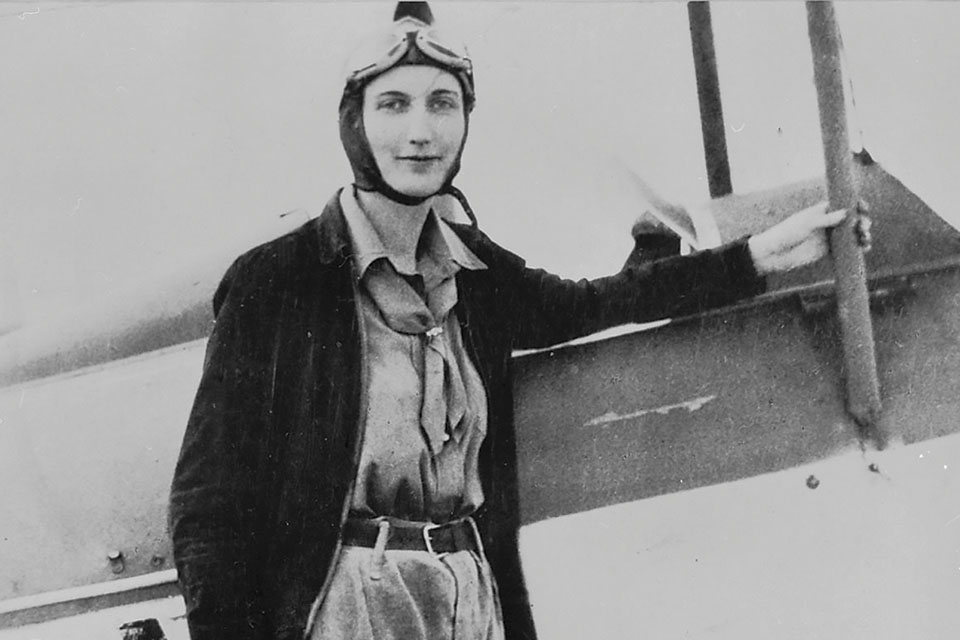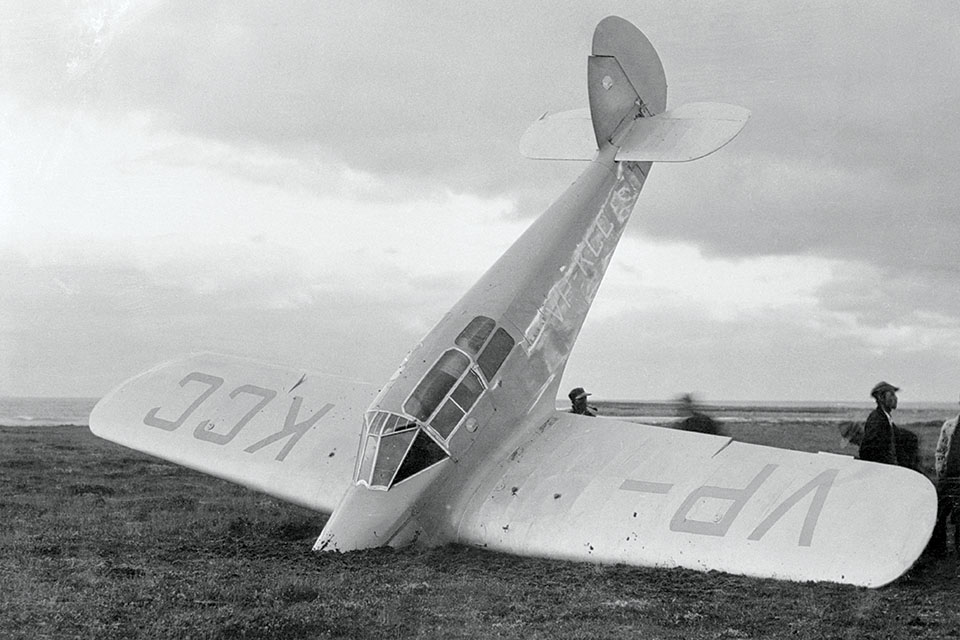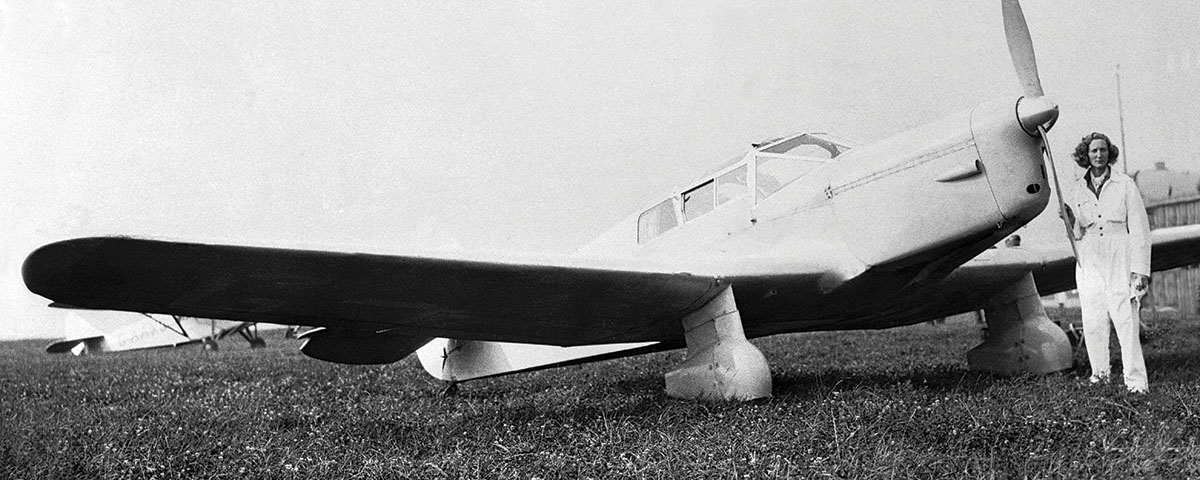The small single-engine monoplane emerged from the Atlantic sky and, nearly out of fuel, flew low over the inhospitable, boulder-strewn Nova Scotian landscape.
Desperately seeking a place to land and weary after more than 21 hours at the controls, the pilot set the monoplane down on what appeared to be a solid surface. Unfortunately, it turned out to be a soggy peat bog. Seconds later, the plane nosed over, the pilot suffering a gash to her forehead. Extracting herself with difficulty from the cockpit, the tall blonde aviator promptly found herself up to her shins in glutinous mud. No matter. She was safe, if desperately short of sleep and ravenous after eating only a packet of chicken sandwiches during the entire flight. It was September 5, 1936, and she had just become the first woman to fly the Atlantic solo the hard way—from east to west, against the prevailing winds. She was also the first person to fly directly across the Atlantic from England. Her name was Beryl Markham and, as a bush pilot from Kenya, she was well outside her equatorial comfort zone.
Born Beryl Clutterbuck on October 26, 1902, in the English village of Ashwell, she had moved with her family to colonial British East Africa (Kenya from 1920) at the age of 4. Unlike her mother who, disliking the isolation, soon headed back to England, young Beryl thrived amid the hardships and challenges of settler life. Often left to her own devices while her ex-soldier father developed their farm and horse-racing stable, she formed friendships with the African farm workers’ children, learning to speak their tribal languages and becoming fluent in Swahili. Barefoot and clutching a spear, she joined hunting parties as they scoured the bush for game. The fearless and strongly independent youngster even opted to sleep in her own mud hut. Like the father she hero-worshipped, she was an accomplished rider and, in her late teens, became Kenya’s first female licensed racehorse trainer.
Three times married and divorced, in later life she used the surname of her second husband, Mansfield Markham, with whom she had her only child, a son, Gervase. As someone with a decidedly relaxed attitude toward her wedding vows, the whiff of scandal seemed to follow the vivacious Mrs. Markham around like a comet’s tail. An awed Kenyan contemporary described her as “A magnificent creature, very feline. It was like watching a golden lioness when she walked across the room.”
But it was not until 1931, after making several flights with the renowned professional hunter Denys Finch Hatton, that Markham caught the flying bug. She asked Finch Hatton to teach her to fly, but as a relative novice himself, he sensibly declined. Markham then turned to another friend, the debonair Captain Tom Campbell Black, a Royal Naval Air Service (RNAS) and Royal Air Force (RAF) veteran then working as the managing director and chief pilot of the Nairobi-based Wilson Airways. Under his painstaking instruction in a de Havilland DH.60 Gipsy Moth biplane, she soon began to show a precocious natural ability in the air. So close did the flying bond between Markham and Campbell Black become that she would always regard him as her mentor and guide in all aviation matters. They even talked of emulating British record-setters Amy Johnson and Jim Mollison as a way to fame and fortune. Although still married, Markham soon became involved in a long-term affair with Campbell Black.
To build up her flying hours, Markham bought an Avro Avian IV two-seater biplane, soon to be repainted in her blue-and-silver horse-racing colors. In April and May 1932, with only 127 hours in her logbook, she flew the tiny airplane 6,000 miles by stages, with several forced landings, via the Sudan and Egypt across the Mediterranean and Europe to England. Months later she flew back to Kenya, completing an astonishing feat of airmanship and navigation for someone so relatively inexperienced. As a token life-preserver while crossing the Mediterranean, she wore an inflated inner-tube!
Markham obtained her commercial license in September 1933 with just under a thousand hours in her logbook. Her early commercial work included taking joyriding tourists in the Avian along the Mombasa coastline. She delivered mail and supplies to the goldmines of Kakamega in western Kenya, often using tiny airstrips hacked from the featureless bush by the miners themselves. Markham also flew in doctors and medical supplies to isolated farms and bush outposts. Although it was a hazardous way of earning a living, she thrived on the daily challenges.
By late 1933 she had started to work as an aerial big-game spotter for hunting safaris, a technique pioneered by Finch Hatton and Campbell Black, but taken to new levels of precision by Markham. These hunting safaris were big business in 1930s East Africa, attracting wealthy clients, including royalty, from Europe and America.

As the first pilot to offer aerial game-scouting on a commercial basis, Markham specialized in finding elephants, although she was always prepared to search for any game animals on a client’s trophy list, including lion, buffalo and rhino. Her directional instructions, dropped to the hunters in leather message bags, were meticulous in the extreme, detailing the animal and herd size, the density of the surrounding bush, the distance away from the hunting party and a precise compass bearing to follow. More often than not, she worked for safaris led by her professional hunter friend, the Swedish Baron Bror von Blixen-Finecke, former husband of Karen Blixen, author of the classic Out of Africa. Markham herself was never interested in big-game trophy hunting, preferring to photograph the animals.
When the safari season ended, Markham used her Avian as an aerial taxi for upcountry residents. Later, to increase her operating capacity, she acquired a three-seater DH.85 Leopard Moth high-wing cabin monoplane.
In October 1934, Markham received news that Campbell Black and Charles Scott had won the prestigious Mildenhall-to-Melbourne MacRobertson Air Race flying the DH.88 Comet Grosvenor House. This was one of the contests that she had hoped to enter with Campbell Black. Not long after she learned that he had married actress Florence Desmond.
Deeply upset, Markham determined to demonstrate that her piloting skills were the equal of Campbell Black’s and his record-setting contemporaries. She wanted to set a record that would resonate around the world, conceivably the London–Cape Town–London route, or some form of transatlantic record.
These ambitions began to crystallize in February 1935 when Markham sold her Avian to finance another trip to England. Once there she hoped to persuade Campbell Black to join her in a record attempt on the Cape Town route or, failing that, to go it alone by finding a rich backer to finance a solo record attempt.
But it was not until March 1936 that, accompanied by Bror Blixen, Markham left Kenya in her Leopard Moth to reprise her 1932 flight to England. Although Campbell Black had offered to arrange interviews for several flying jobs in Britain, she sought something more than that: an objective that would make the headlines of the world’s newspapers.
Ironically, when eventually she found a wealthy patron, it turned out to be an old Kenya settler friend, John C. Carberry, who had been a member of Britain’s 1914 Schneider Trophy team and later served in the RNAS. Carberry was in England at that time, awaiting the completion of a Percival Vega Gull he was having built to compete in the Schlesinger African Air Race between Portsmouth and Johannesburg, scheduled for late September 1936. Impulsively he offered the Vega Gull to Markham for an east-west solo transatlantic attempt, conditional on her getting it back to England in time for him to compete in the Schlesinger. She readily agreed.
Jim Mollison had made the first westward solo crossing of the North Atlantic, on August 18-19, 1932, flying between Ireland and Canada in a DH.80A Puss Moth. Mollison had been aiming for New York and so judged the flight a partial failure. Markham also decided to head for New York but, on Carberry’s advice, chose to start from England.
The Vega Gull, dubbed The Messenger, was an elegant low-wing, fabric-covered, four-seater monoplane, powered by a 200-hp de Havilland Gipsy Six II engine driving a Ratier variable-pitch propeller. In standard configuration it had a 174-mph maximum speed, 150-mph cruising speed and a range of about 660 miles. For Markham’s transatlantic flight, several extra fuel tanks were fitted, including two in the cabin, to take on the 255 gallons of gasoline needed to reach New York, giving a theoretical range of about 3,800 miles. The fixed undercarriage was specially strengthened to carry the extra load. All the supplementary tanks were controlled by hand-operated petcocks. The cabin tanks had no gauges, but each contained enough fuel for about four hours. Markham was cautioned that proper use of the petcocks to control the flow of fuel was vital. Were she to open one without first shutting the other, an airlock might result, blocking the fuel flow. There was no room in the Gull’s cabin for a radio.
Campbell Black spent many hours helping Markham with her training regime and detailed preflight planning. To obtain firsthand knowledge of the conditions she was likely to encounter along the route, he also introduced her to Jim Mollison, who soon became a close friend. They chose RAF Abingdon, with its mile-long runway, as the departure point.
Adverse North Atlantic weather delayed the departure until 1850 hours (BST) on September 4, 1936, when Markham, in the pilot’s seat for only the third time, took off in The Messenger and headed west toward Ireland and the vast Atlantic. Among the onlookers, Mollison and airplane designer Edgar Percival watched approvingly as she coolly held the Gull down until it gathered sufficient speed to lift its heavy load. Campbell Black was away, apparently because he doubted she would fly in such unfavorable weather. “Well, that’s the last we’ll see of Beryl,” quipped Mollison to Percival. Nonetheless, as an optimistic token, Mollison had loaned Markham the cherished wristwatch he had used on his successful transatlantic flights.
Nothing was heard of the Gull until 2225 BST, when it was observed overflying Castletown, Ireland, 328 miles from Abingdon. In her autobiography, West With the Night, Markham recalled of this time in the flight: “We are bound for a point thirty-six hundred miles from here – two thousand of it unbroken ocean. Most of it will be by night….I am flying along the Great Circle Course for Harbour Grace, Newfoundland, into a forty mile headwind at a speed of 130 mph.”
She had been flying on a cabin tank estimated to last four hours when suddenly, she wrote, “My motor coughs and dies and the Gull is powerless.” For some 30 heart-stopping seconds, while the monoplane sank toward the waves, Markham grappled frantically with awkward petcocks until at last “the motor explodes into life again.”
As Markham flew on, interminable dark and monotonous hours of instrument flying in the cramped cockpit were at last ended when she sighted “A lighted ship – the daybreak – some steep cliffs. The meaning of these will never change for a pilot….I felt the elation I had so long imagined….We had flown blind for nineteen hours.” It was a magnificent feat of navigation. The ship was the SS Spaarndam, which reported sighting the Gull at 1400 BST, some 200 miles from Newfoundland, headed west.
Soon after the Gull was spotted circling the Cape Race lighthouse on the southeastern tip of Newfoundland’s Avalon peninsula before heading for the Gulf of Saint Lawrence. “After a while there would be New Brunswick, Maine and then New York,” Markham wrote. “…Four hundred miles of water, but then again land at Cape Breton. I would stop at Sydney to refuel and go on….New York was my goal.”

Fate, meanwhile, had another card to play. “My engine began to shudder before I saw the land. It died. It spluttered, it started again and limped along. Airlock, I thought.” Hoping she might clear the airlock by turning the empty tanks on and off, she cut her hands on the sharp metal petcocks, blood dripping onto her maps and clothes, to no avail. The engine ran on intermittently until at last, over Nova Scotia’s Cape Breton, an estimated 12 minutes from Sydney airfield, it cut out completely, leading to that tail-up landing in the Baleine Cove peat bog. (The “airlock” was later attributed to ice lodged in the air intake of the last petrol tank, partially choking the fuel flow to the carburetor.) Since departing England, Markham had covered an extraordinary 2,612 miles in 21 hours and 35 minutes.
Rescued by local fishermen, she was taken to a telephone, from which she reported to Sydney airfield. Next day, her forehead bandaged, she was flown to Halifax and a civic reception. Waiting at the airfield was a U.S. Coast Guard Beechcraft 17, which flew her to Floyd Bennett Field, where a rapturous crowd welcomed her. Over the following packed days, the glamorous, party-loving Markham delighted in New York’s generous hospitality and tickertape welcome. But then came the shattering news that Tom Campbell Black was dead, killed on September 19 at Liverpool Airport in a ground collision between the Percival Mew Gull he was intending to pilot in the Schlesinger Race and an RAF Hawker Hart light bomber.
The trusting John Carberry, of course, never did get to fly his Vega Gull in the Schlesinger. After it was extracted from the Nova Scotian mud, it was shipped back to England and then East Africa, where it was sold to Dar-es-Salaam Airways.
Markham returned to England where, over the ensuing years, she was frequently reported as entering races or seeking sponsorship for record attempts. But nothing ever came of it. Nor did she show any interest in returning to bush flying. It was as if Campbell Black’s tragic death had deprived her of a vital motivational spark—as if she no longer had anything to prove.
She went back to the United States in 1939, living there until 1950, when the siren call of Africa drew her back to Kenya and, eventually, to another period as one of the country’s most successful racehorse trainers. She died in Nairobi on August 3, 1986, aged 83.
Today, Beryl Markham and her epic transatlantic flight are all but forgotten. Few can doubt, however, that had this extraordinary woman so chosen, with her courage, gritty self-confidence and flying skills, she could have ranked alongside such aviation greats as Amelia Earhart, Amy Johnson and Jean Batten.
RAF veteran Derek O’Connor writes from Britain. For further reading, he recommends: West With the Night, by Beryl Markham; and Straight on Till Morning: The Life of Beryl Markham, by Mary S. Lovell.
This feature originally appeared in the November 2017 issue of Aviation History Magazine. Subscribe today!

